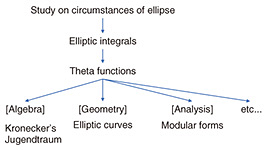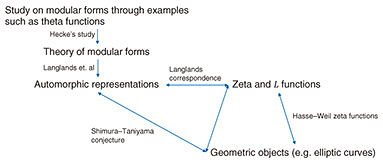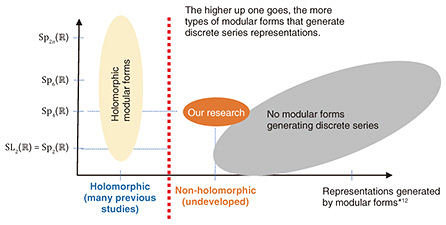 |
|||||||||||||||||||||||||||||||
|
|
|||||||||||||||||||||||||||||||
|
Feature Articles: Challenging the Unknown: Mathematical Research and Its Dreams Vol. 22, No. 9, pp. 59–64, Sept. 2024. https://doi.org/10.53829/ntr202409fa7 Modular Forms and Fourier ExpansionAbstractFourier analysis is an indispensable technology, but so is mathematics. In this article, we review the history of modular forms and give an overview of the relationship among representation theory, Fourier analysis, and modular forms. The explanation of difficult terms is confined to footnotes, and we focus on the relationship between the concepts. Finally, we discuss the remaining difficulties in the modern theory of modular forms, challenges, and the author”Ēs research. Keywords: modular forms, Fourier analysis, representation theory 1. History of modular forms and remaining problemsOne of the origins of modular forms*1 is the study of elliptic functions that began in the 1800s when the accuracy of stargazing methods became more precise and astronomy improved rapidly. Since orbits of astronomical objects are generally ellipses, we need to measure the circumference of ellipses. Of course, it is easy to compute the circle’s circumference in terms of 𝜋, but with ellipses, it is challenging and written as the (second) elliptic integral. Through the studies of Legendre, Gauss, and Abel, elliptic integrals became not only the circumference of ellipses but also interesting objects connecting to modern mathematics. A notable example is the theta function. Theta functions are used in various areas of mathematics (Fig. 1). They are typical examples of modular forms, a central theme of this article, and play crucial roles in elliptic curves and number theory. As another application, Kronecker constructed class fields of imaginary quadratic fields. This study is called Kronecker’s Jugendtraum and is a significant result relating to a part of Hilbert’s 23rd problem*2. The study of modular forms started in this way with typical examples.
1.1 Developments of the theory of modular forms and obstructionsTo further developments in the theory of modular forms, we needed to wait for the study of modular forms of Hecke, a student of Hilbert. Of course, there are many known results for modular forms, but Hecke arranged such results and initiated the theory of modular forms. Hecke defined the zeta functions and L functions for modular forms on the basis of the Riemann zeta function. These results opened the way for the theory of modern modular forms. This theory became the theory of automorphic representations through the works of Langlands and other mathematicians. To review the theory of automorphic representations, the Shimura–Taniyama conjecture is one of the most significant results. It is a profound conjecture that connects automorphic representations and elliptic curves. In 1995, Wiles solved the “semistable” case of the conjecture, proving Fermat’s conjecture completely. The Shimura–Taniyama conjecture has now been completely proven. The paramodular conjecture, a generalization of the Shimura–Taniyama conjecture, has been partially proved. To formulate these conjectures, it is necessary to use automorphic representations, which also play a vital role in these conjectures. We stated that the Shimura–Taniyama conjecture connects geometric objects, such as elliptic curves, and analytic objects such as holomorphic modular forms. Through the pioneering studies of many researchers, for example, Shimura and Langlands, the Shimura–Taniyama conjecture exceeds the original formulation and became a theory to unify algebra, analysis, and geometry (Fig. 2). However, there is a remaining problem in the theory of modular forms, i.e., a study of non-holomorphic modular forms. Shimura and Taniyama formulated the conjecture on the basis of many numerical computations of Fourier coefficients of modular forms. However, no known examples of Fourier coefficients of non-holomorphic modular forms exist. The lack of such examples is an obstruction of further development. Recall that we prove the Shimura–Taniyama conjecture and hypersphere packing problem*3 using holomorphic modular forms. It is easy to imagine that non-holomorphic modular forms have several applications similar to holomorphic modular forms, but there is room for improvement in modular forms. In this article, we first discuss the relationship between Fourier expansion and representation theory then discuss the Langlands conjecture and Arthur conjecture, which may be viewed as a generalization of the relationship, and introduce a joint study with myself and Narita, a professor of Waseda University, about Fourier expansion of non-holomorphic modular forms.
2. Fourier expansion and representation theory2.1 Fourier expansionMany people may have heard of Fourier expansion and Fourier transform. These are indispensable techniques for modern society; for example, they are frequently used to process sound signals. No matter how complicated sounds are, we may construct complex sounds using simple ones such as the time signals on television and radio. This point of view is the method of Fourier transform and Fourier expansion. In mathematics, one may regard such simple sounds as sin x and cos x functions. In pure mathematics, Fourier expansion means an expansion of periodic functions as sin x and cos x, and Fourier coefficients are the coefficients in such an expansion. Fourier expansion plays a significant technical and theoretical role in modern mathematics. We first discuss the relationship between Fourier analysis and representation theory. The philosophy of Fourier expansion and Fourier transform is to understand the space of periodic functions via the translations for periodic functions. To understand this, we discuss the mathematical details. Let ƒ be a complex-valued function on the space of real numbers ℝ. We say that ƒ has the period 1 if ƒ(x + 1) = ƒ(x) for any x ∈ ℝ. Thus, we may regard ƒ as a function on ℝ/ℤ. The theory of Fourier expansion tells us to rewrite ƒ as a sum of sin x and cos x. More precisely, by
Such an expression is called Fourier expansion, and coefficients an are the Fourier coefficients. It is known that an equal Fƒ(n), where Fƒ is the Fourier transform. In representation theory, we divide mathematical objects, such as periodic functions, into smaller objects with more precise conditions such as periodic functions. A typical example of representation theory is the action of matrices on vector spaces. We can easily understand the action of matrices by dividing them into eigenvalues and eigenvectors. Such a framework is one fundamental aspect of representation theory. Next, we discuss the relationship between Fourier analysis and representation theory. In the above representation theoretical method, we consider the vector spaces and the matrices acting on them as the space of periodic functions and the “translation,” respectively. For a periodic function ƒ and real number y ∈ ℝ, we define the translation ry by ryƒ(x) = ƒ(x + y). Then, the n-th Fourier coefficient of ryƒ equals an
We thus grasp one face of representation theory by connecting a function and representations, a mysterious object. We may find this a surprising correspondence in a broad framework rather than an easy object ℝ/ℤ. The central theme of the next section is a generalization of such surprising correspondence. 2.2 From Fourier analysis to Langlands conjectureWe deeply observe the relationship between functions and representations for ℝ/ℤ and period functions. A fundamental property is the “compactness” of ℝ/ℤ. For a non-compact object such as the real numbers ℝ, such correspondence becomes more difficult due to technical difficulties, for example, a convergence of integrals. We may find differences between Fourier analysis of period functions and a function on ℝ in certain literature on Fourier analysis. The nature of these differences comes from the topological property of ℝ and ℝ/ℤ, i.e., the non-compactness of ℝ. Harish-Chandra produced a breakthrough in the representation theory of reductive groups, one of the most essential classes of non-compact groups. He mainly considered the Lie groups, containing ℝ and ℝ/ℤ. His pioneering work is the classification of discrete series representations. Recall that we consider the space of functions for ℝ and ℝ/ℤ. For reductive groups G, he considered the space L2(G) of square-integrable functions*4 and translations on it. We may naturally find discrete series representations in L2(G). A realization of discrete series representations on L2(G) is done by matrix coefficients*5. Like this, we highly develop the representation theory through a space of certain functions and analysis. On the basis of Harish-Chandra’s study, Knapp and Zuckerman classified the tempered representations, and Langlands classified all the irreducible representations of Lie groups (Table 1). This classification is due to Langlands and is called the Langlands classification. Since Lie groups are a theory for ℝ or complex numbers ℂ, number theorists need a similar theory for p-adic groups.
On the basis of various trials and errors, the local Langlands conjecture, the classification theory of irreducible representations on p-adic groups, was becoming clear. The local Langlands conjecture states the correspondence of the following two objects for a connected reductive group G*6: {Irreducible representations of G} → {L parameters of G}. L parameters on the right side are arithmetic objects and define an L function. As in another article [1] in this issue, one aspect of the local Langlands conjecture is a non-commutative class field theory. Such an aspect appears in the L parameters. The local Langlands conjecture has made significant progress and become more precise. It is now called the endoscopic classification. The representation theory of p-adic groups and modular forms or automorphic representations are inseparable. They have a history of developing together while compensating for each other’s weaknesses. Finally, we discuss the author’s results for the Fourier expansion of non-holomorphic modular forms.
3. Modular forms and representation theory3.1 Fourier expansion of holomorphic modular formsWe first consider the Fourier expansion and coefficients of holomorphic modular forms. Let
Surprisingly, an are independent of the imaginary part y under this expression. This expression is usually called the Fourier expansion of ƒ, and an are called the Fourier coefficients of ƒ. 3.2 Modular forms and representation theoryWe observed a strong relationship between translations on function spaces and representation theory. Similar phenomena may occur for modular forms. More precisely, we may lift modular forms to functions on a Lie group. Let φƒ be the lift of ƒ. We then may regard φƒ as a function on C∞(Γ∖SL2(ℝ)). As we have seen in the section discussing the Fourier expansion, one can define the right translation by SL2(ℝ) on the space Γ∖SL2(ℝ). Thus, modular forms and representation theory of SL2(ℝ) relate. With a similar method, modular forms would become a function φƒ on an adele group SL2(𝔸) using the adele ring 𝔸 of ℚ. If ƒ is square-integrable or more strongly ƒ is a cusp form, φƒ is a function on L2(SL2(ℚ)∖SL2(𝔸)). We summarize that from a square-integrable modular form ƒ, the function φƒ becomes a function on L2(SL2(ℚ)∖SL2(𝔸)) and relates representations of SL2(ℝ) and SL2(ℚp). This phenomenon resembles Fourier analysis and representation theory (Fig. 3).
In the modern modular form theory, we generalize SL2 in L2(SL2(ℚ)∖SL2(𝔸)) to a connected reductive group. Like Harish-Chandra’s study on discrete series, we may consider the discrete spectrum of L2(SL2(ℚ)∖SL2(𝔸)). A recent study gives us a description of such a discrete spectrum. This study is based on the research of many researchers. Arthur, a student of Langlands, established the Arthur conjecture, which describes the discrete spectrum and proves his conjecture for orthogonal and symplectic groups under appropriate modification. This study is one of the highest peaks in modern theory of modular forms. Many researchers now consider generalizations and applications of Arthur’s study. 3.3 Toward the generalization of Fourier expansion of modular formsWe saw that the Fourier coefficients of holomorphic modular forms ƒ are constant. This fact is based on the holomorphy of ƒ. Thus, if we remove the holomorphy assumption, the Fourier expansion of ƒ is expressed as
The coefficients an(y) depend on the imaginary part y. Therefore, it is not easy to consider an(y). In the joint study with Narita [2], we treat such Fourier expansion of non-holomorphic modular forms. A typical example of a non-holomorphic modular form is a Maass form, but we do not treat Maass forms. Our main target is a modular form naturally arising from representation theory*12. Discrete series representations are a key idea in our joint study. We recall Harish-Chandra’s classification of discrete series representations to understand the idea. The modular form on the upper half plane corresponds to a function on SL2(ℝ). In a certain sense, there is essentially only one discrete series representation of SL2(ℝ). One of the difficulties of Maass form is that the corresponding representation is not a discrete series representation. An example of a group with non-holomorphic discrete series representations is the symplectic group Sp4(ℝ) of degree two. For Sp4(ℝ), there are essentially two discrete series representations in a certain sense. One is holomorphic and the other one is non-holomorphic. Also, Sp4(ℝ) is a minimal with such a property. We may define a modular form on Sp4(ℝ). Such a modular form is a function on the Siegel upper half plane
The ah(y) are called the generalized Whittaker function. Unlike holomorphic modular forms, ah(y) are never a constant. We can introduce a differential equation to evaluate ah(y) when considering the discrete series representations. In our joint study, we explicitly compute the solution of the differential equation and prove several properties of ah(y). As an application, we explicitly describe the space of all the non-cuspidal automorphic forms, generating discrete series representations of Sp4(ℝ). As in Fig. 4, this joint study is the first to describe all the non-cuspidal modular forms, including their construction. In our next joint study, we will consider an explicit computation of Fourier coefficients. We will extend our research to provide an arithmetic property of L function through explicit computation of modular forms corresponding to discrete series representations.
References
|
|||||||||||||||||||||||||||||||















